Train-Induced Vibration and Structure-Borne Noise Measurement and Prediction of Low-Rise Building
Abstract
:1. Introduction
2. Measurement
2.1. Measured Site Descriptions
2.2. Measurement Program
Instrumentation and Signal Processing
- (1)
- Initial reconnaissance
- (2)
- Pre-processing
- (a)
- All instruments were calibrated based on the laptop’s time prior to measurement initiation, ensuring simultaneous data recording.
- (b)
- According to the Chinese code HJ 453–2018 [30], the dominant frequency range requirement for structure-borne noise analysis is 16–200 Hz. The sampling frequency for each sound level meter was set at 48 kHz, and it was chosen to facilitate noise analysis up to 24 kHz, despite such high frequencies not being typically necessary for noise analysis but sufficient for the common frequency of interest at 16–200 Hz for train-induced structure-borne noise. The sampling frequency was 512 Hz, which captured vibrations resulting from train passage and offered spectral information up to the Nyquist frequency of 256 Hz, allowing for analysis within the frequency range of 16–200 Hz.
- (c)
- After setting the instrumentation and starting the measuring, train pass-by events were simultaneously documented at the metro station, including details of the specific tunnel from which each train originated.
- (3)
- Post-processing
3. Results
3.1. Vibration in Time Domain
3.2. Structure-Borne Noise in Time Domain
3.3. Vibration in Frequency Domain
3.4. Structure-Borne Noise in Frequency Domain
3.5. Transfer Function from Structural Vibration to Structure-Borne Noise
4. Hybrid Approach for Prediction
4.1. Structural Vibration Estimation Model
4.2. Structure-Borne Noise Estimation Model
4.3. Model Validation
4.4. Error Analysis
4.5. Model Limitation Discussion
5. Conclusions
- (1)
- The vibration acceleration characteristics of building components are closely associated with the vibration frequency, showing significant differences in performance across different frequency bands.
- (2)
- Noise within the indoor structure of buildings is not uniformly distributed; corner areas exhibit more pronounced noise than central indoor floor areas.
- (3)
- There exists a positive correlation between structural vibration and structure-borne noise, where greater structural vibrations lead to more noticeable structure-borne noise. The characteristic frequency band of structure-borne noise falls within 25 Hz–80 Hz.
- (4)
- The hybrid prediction method effectively forecasted the impact of subway vibration and structural noise on surrounding buildings under specific working conditions. This method demonstrate high prediction accuracy with a simple and convenient calculation process and is suitable for the preliminary prediction and confirmation stage of specific engineering projects.
Author Contributions
Funding
Data Availability Statement
Conflicts of Interest
References
- Ma, M.; Xu, L.; Liu, W.; Tan, X. Semi-analytical solution of a coupled tunnel-soil periodic model with a track slab under a moving train load. Appl. Math. Model. 2024, 128, 588–608. [Google Scholar] [CrossRef]
- He, C.; Jia, Y.; Zhou, S. Semi-analytical method for calculating ground vibrations from a tunnel in a homogeneous half-space with an irregular surface. J. Sound Vib. 2024, 591, 118615. [Google Scholar] [CrossRef]
- Li, X.; Chen, Y.; Zou, C.; Wang, H.; Zheng, B.; Chen, J. Building structure-borne noise measurements and estimation due to train operations in tunnel. Sci. Total Environ. 2024, 926, 172080. [Google Scholar] [CrossRef] [PubMed]
- Sheng, X.; Jones, C.J.C.; Thompson, D.J. A theoretical model for ground vibration from trains generated by vertical track irregularities. J. Sound Vib. 2004, 272, 937–965. [Google Scholar] [CrossRef]
- Hu, J.; Zou, C.; Liu, Q.; Li, X.; Tao, Z. Floor vibration predictions based on train-track-building coupling model. J. Build. Eng. 2024, 89, 109340. [Google Scholar] [CrossRef]
- Auersch, L. Simple and fast prediction of train-induced track forces, ground and building vibrations. Railw. Eng. Sci. 2020, 28, 232–250. [Google Scholar] [CrossRef]
- Sanayei, M.; Zhao, N.; Maurya, P.; Moore, J.A.; Zapfe, J.A.; Hines, E.M. Prediction and mitigation of building floor vibrations using a blocking floor. J. Struct. Eng. 2012, 138, 1181–1192. [Google Scholar] [CrossRef]
- Zou, C.; Moore, J.A.; Sanayei, M.; Wang, Y. Impedance model for estimating train-induced building vibrations. Eng. Struct. 2018, 172, 739–750. [Google Scholar] [CrossRef]
- Zou, C.; Moore, J.A.; Sanayei, M.; Tao, Z.; Wang, Y. Impedance model of train-induced vibration transmission across a transfer structure into an overtrack building in a metro depot. J. Struct. Eng. 2022, 148, 04022187. [Google Scholar] [CrossRef]
- Papadopoulos, M.; François, S.; Degrande, G.; Loimbaert, G. The influence of uncertain local subsoil conditions on the response of buildings to ground vibration. J. Sound Vib. 2018, 418, 200–220. [Google Scholar] [CrossRef]
- Edirisinghe, T.L.; Talbot, J.P. The significance of source-receiver interaction in the response of piled foundations to ground-borne vibration from underground railways. J. Sound Vib. 2021, 506, 116178. [Google Scholar]
- Li, S.; Wang, J.; Han, K.; Wang, L.; Zhang, D.; Dong, H.; Cui, B. Promoting effect and microscopic mechanism of train-induced vibration on loess disintegration. Eng. Geol. 2024, 336, 107559. [Google Scholar]
- Chung, Y.; Gu, K.; Jeon, S.; Park, B.; Park, J. Influence of the Doppler effect and binaural characteristics on perceived annoyance of train pass-by noise. Appl. Acoust. 2023, 211, 109525. [Google Scholar] [CrossRef]
- He, Y.; Thompson, D.; Hu, Z. Aerodynamic noise from a high-speed train bogie with complex geometry under a leading car. J. Wind Eng. Ind. Aerodyn. 2024, 244, 105617. [Google Scholar] [CrossRef]
- Sadeghi, J.; Vasheghani, M. Safety of buildings against train induced structure borne noise. Build. Environ. 2021, 197, 107784. [Google Scholar] [CrossRef]
- Nagy, A.B.; Fiala, P.; Márki, F.; Augusztinovicz, F.; Degrande, G.; Jacobs, S.; Brassenx, D. Prediction of interior noise in buildings generated by underground rail traffic. J. Sound Vib. 2006, 293, 680–690. [Google Scholar] [CrossRef]
- Liu, Q.; Thompson, D.J.; Xu, P.; Feng, Q.; Li, X. Investigation of train-induced vibration and noise from a steel-concrete composite railway bridge using a hybrid finite element-statistical energy analysis method. J. Sound Vib. 2020, 471, 115197. [Google Scholar] [CrossRef]
- Fragasso, J.; Helal, K.M.; Moro, L. Transfer-path analysis to estimate underwater radiated noise from onboard structure-borne sources. Appl. Ocean. Res. 2024, 147, 103979. [Google Scholar]
- Hornikx, M. Acoustic modelling for indoor and outdoor spaces. J. Build. Perform. Simul. 2015, 8, 1–2. [Google Scholar] [CrossRef]
- Fiala, P.; Degrande, G.; Augusztinovicz, F. Numerical modelling of ground-borne noise and vibration in buildings due to surface rail traffic. J. Sound Vib. 2007, 301, 718–738. [Google Scholar]
- Colaço, A.; Costa, P.A.; Amado-Mendes, P.; Godinho, L.; Calçada, R. Mitigation of vibrations and re-radiated noise in buildings generated by railway traffic: A parametric study. Procedia Eng. 2017, 199, 2627–2632. [Google Scholar] [CrossRef]
- Kurzweil, L.G. Ground-borne noise and vibration from underground rail systems. J. Sound Vib. 1979, 66, 363–370. [Google Scholar] [CrossRef]
- Vér, I.L.; Beranek, L.L. (Eds.) Noise and Vibration Control Engineering: Principles and Applications; John Wiley & Sons: Hoboken, NJ, USA, 2005. [Google Scholar]
- Melke, J. Noise and vibration from underground railway lines: Proposals for a prediction procedure. J. Sound Vib. 1988, 120, 391–406. [Google Scholar] [CrossRef]
- Tao, Z.; Moore, J.A.; Sanayei, M.; Wang, Y.; Zou, C. Train-induced floor vibration and structure-borne noise predictions in a low-rise over-track building. Eng. Struct. 2022, 255, 113914. [Google Scholar]
- Dong, Y.; Jiang, H.; Mu, M.; Wang, X. Multi-sensor data fusion-enabled lightweight convolutional double regularization contrast transformer for aerospace bearing small samples fault diagnosis. Adv. Eng. Inform. 2024, 62, 102573. [Google Scholar]
- Dong, Y.; Jiang, H.; Jiang, W.; Xie, L. Dynamic normalization supervised contrastive network with multiscale compound attention mechanism for gearbox imbalanced fault diagnosis. Eng. Appl. Artif. Intell. 2024, 133, 108098. [Google Scholar]
- Wang, X.; Jiang, H.; Wu, Z.; Yang, Q. Adaptive variational autoencoding generative adversarial networks for rolling bearing fault diagnosis. Adv. Eng. Inform. 2023, 56, 102027. [Google Scholar] [CrossRef]
- Quagliata, A.; Ahearn, M.; Boeker, E.; Roof, C.; Meister, L.; Singleton, H. Transit Noise and Vibration Impact Assessment Manual; No. FTA Report No. 0123; Federal Transit Administration, U.S. Department of Transportation: Washington, DC, USA, 2018. [Google Scholar]
- HJ 453–2018; Technical Guidelines for Environmental Impact Assessment—Urban Rail Transit. China Environmental Science Press: Beijing, China, 2018. (In Chinese)
- Auersch, L. Building response due to ground vibration-simple prediction model based on experience with detailed models and measurements. Int. J. Acoust. Vib. 2010, 15, 101. [Google Scholar] [CrossRef]
- Fahy, F.; Walker, J. (Eds.) Advanced Applications in Acoustics, Noise and Vibration; CRC Press: Boca Raton, FL, USA, 2018. [Google Scholar]
- Villot, M.; Guigou, C.; Jean, P.; Picard, N. Report Definition of Appropriate Procedures to Predict Exposure in Buildings and Estimate Annoyance; RIVAS Del.1.6; Railway Induced Vibration Abatement Solutions (RIVAS), European Commission: Brussels, Belgium, 2012. [Google Scholar]
- Sabine, W.C. Collected Papers on Acoustics; Harvard University Press: Cambridge, MA, USA, 1922. [Google Scholar]
- Eyring, C.F. Reverberation time in “dead” rooms. J. Acoust. Soc. Am. 1930, 1, 217–241. [Google Scholar] [CrossRef]
- Zhou, X.; Späh, M.; Hengst, K.; Zhang, T. Predicting the reverberation time in rectangular rooms with non-uniform absorption distribution. Appl. Acoust. 2021, 171, 107539. [Google Scholar] [CrossRef]
- Li, X.; Chen, Y.; Zou, C.; Wu, J.; Shen, Z.; Chen, Y. Building coupling loss measurement and prediction due to train-induced vertical vibrations. Soil Dyn. Earthq. Eng. 2023, 164, 107644. [Google Scholar] [CrossRef]
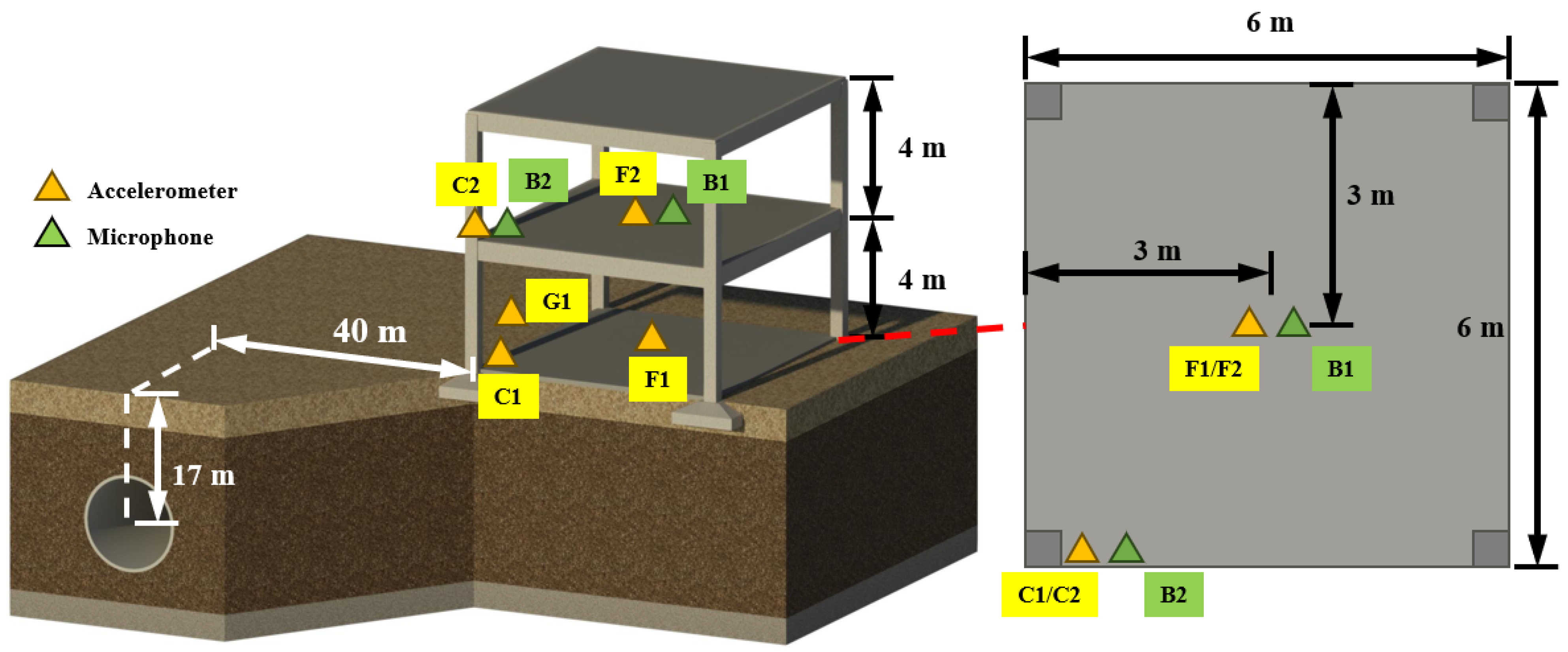
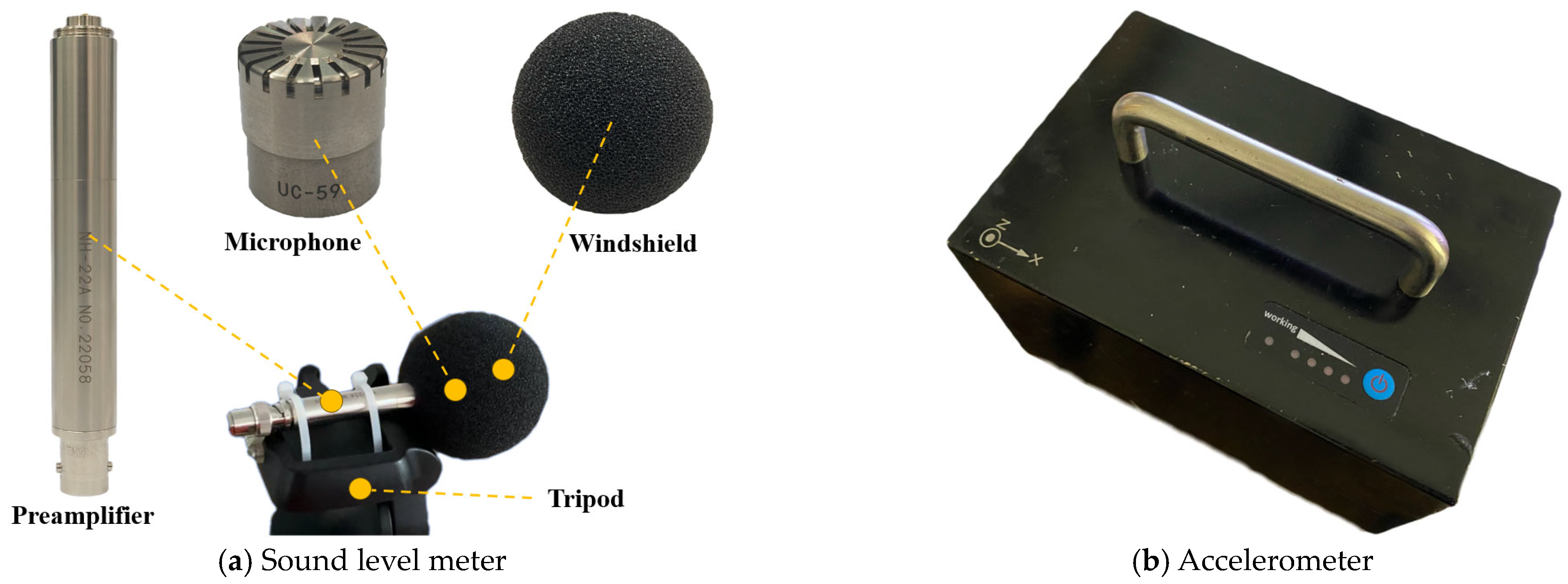
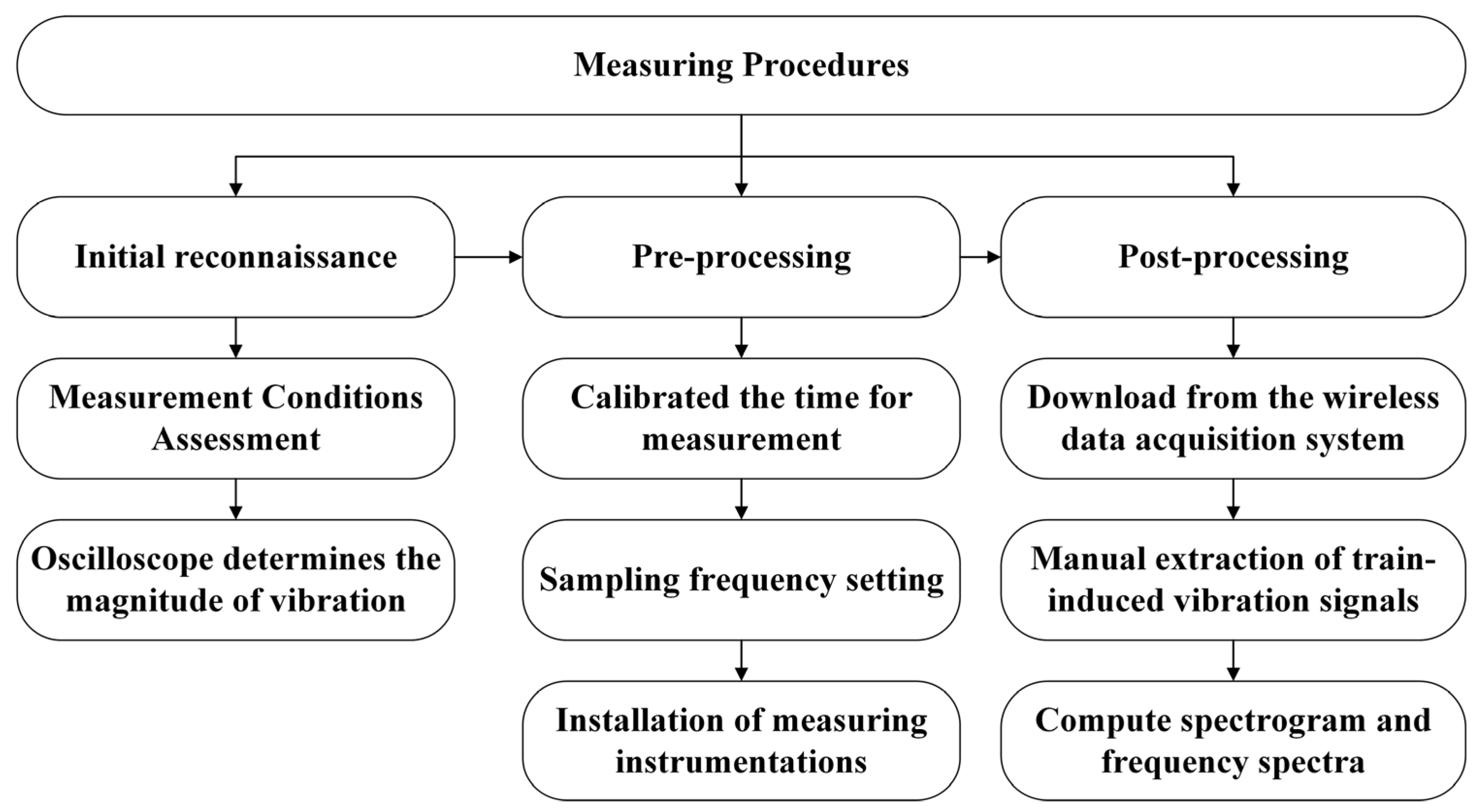
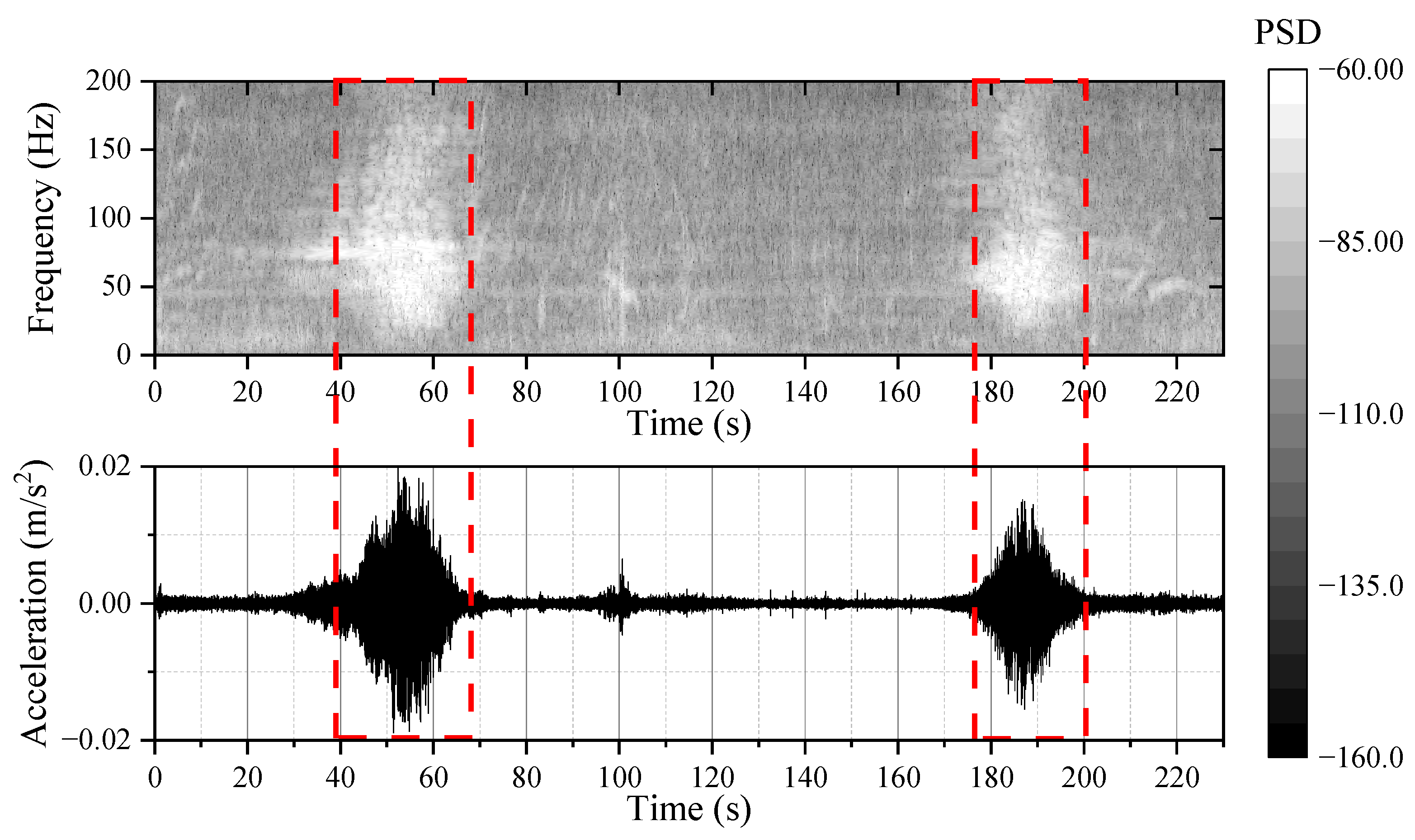
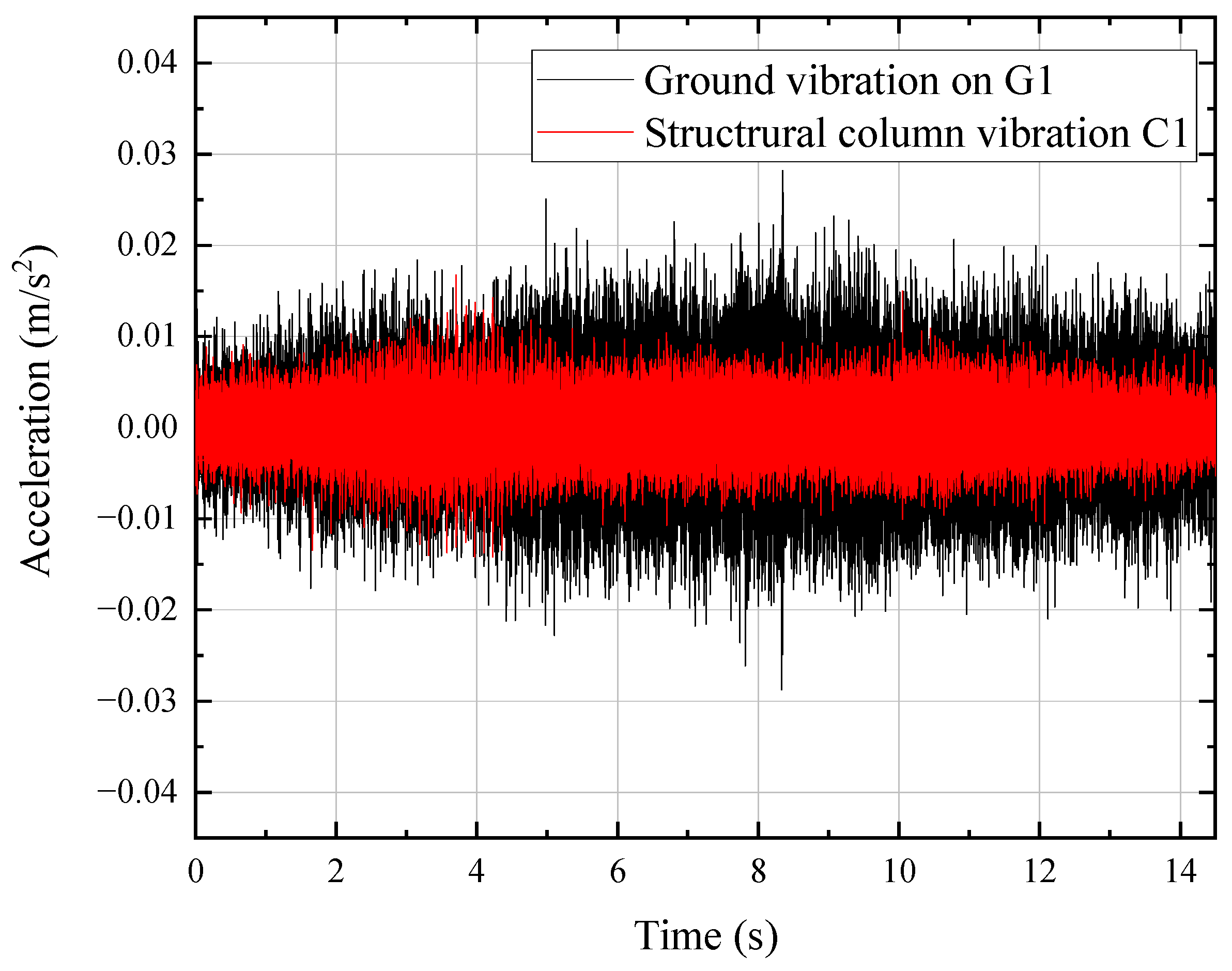
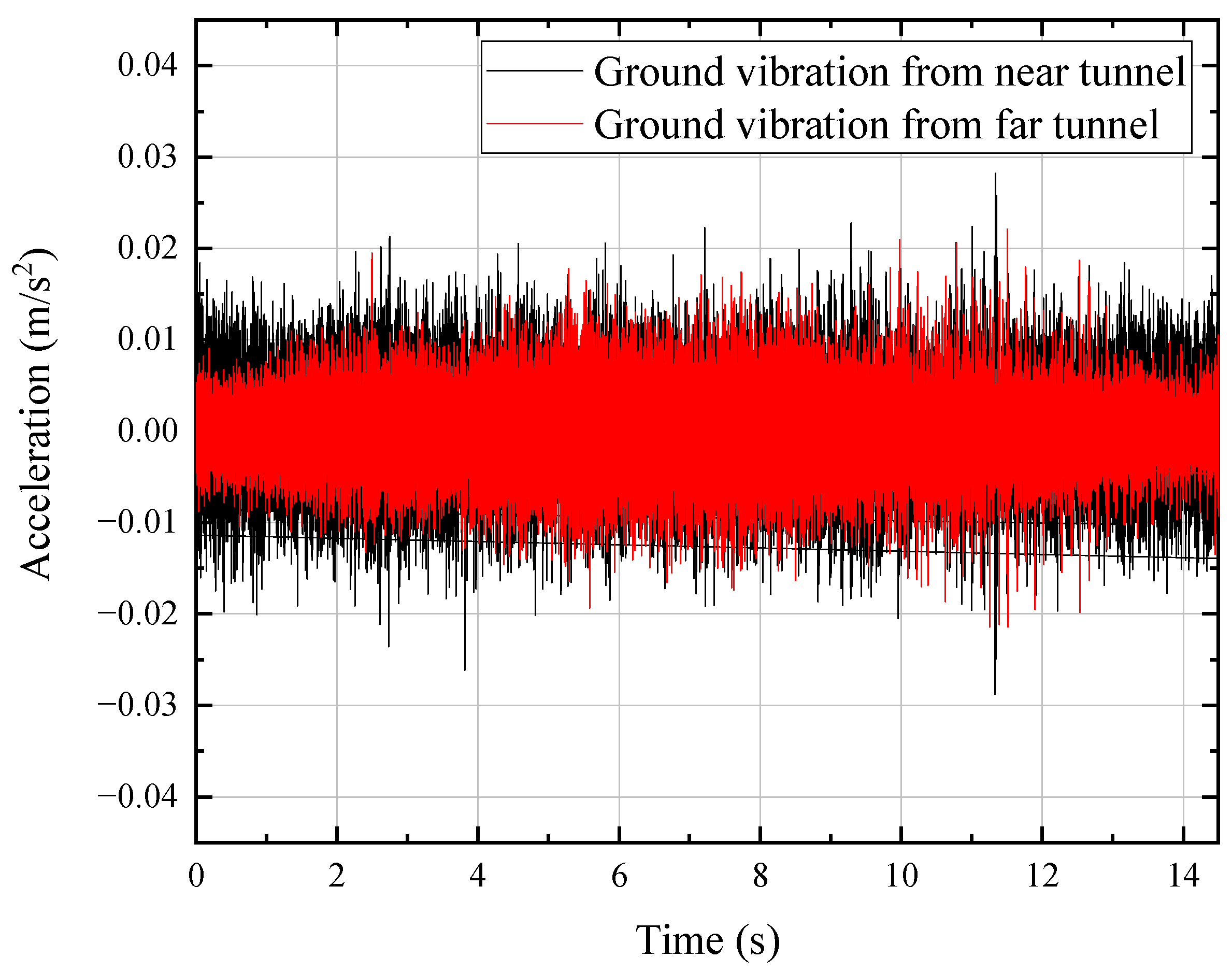


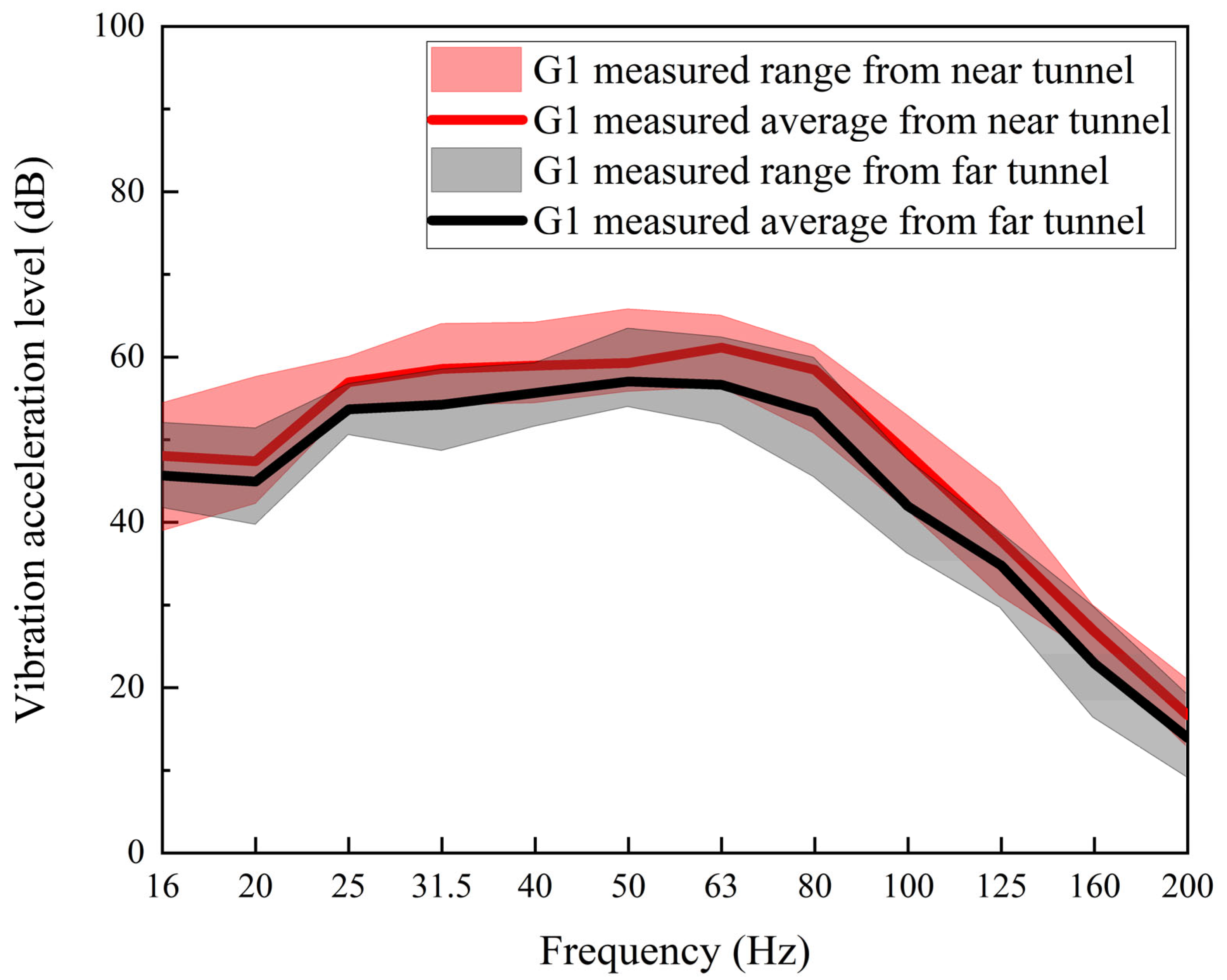
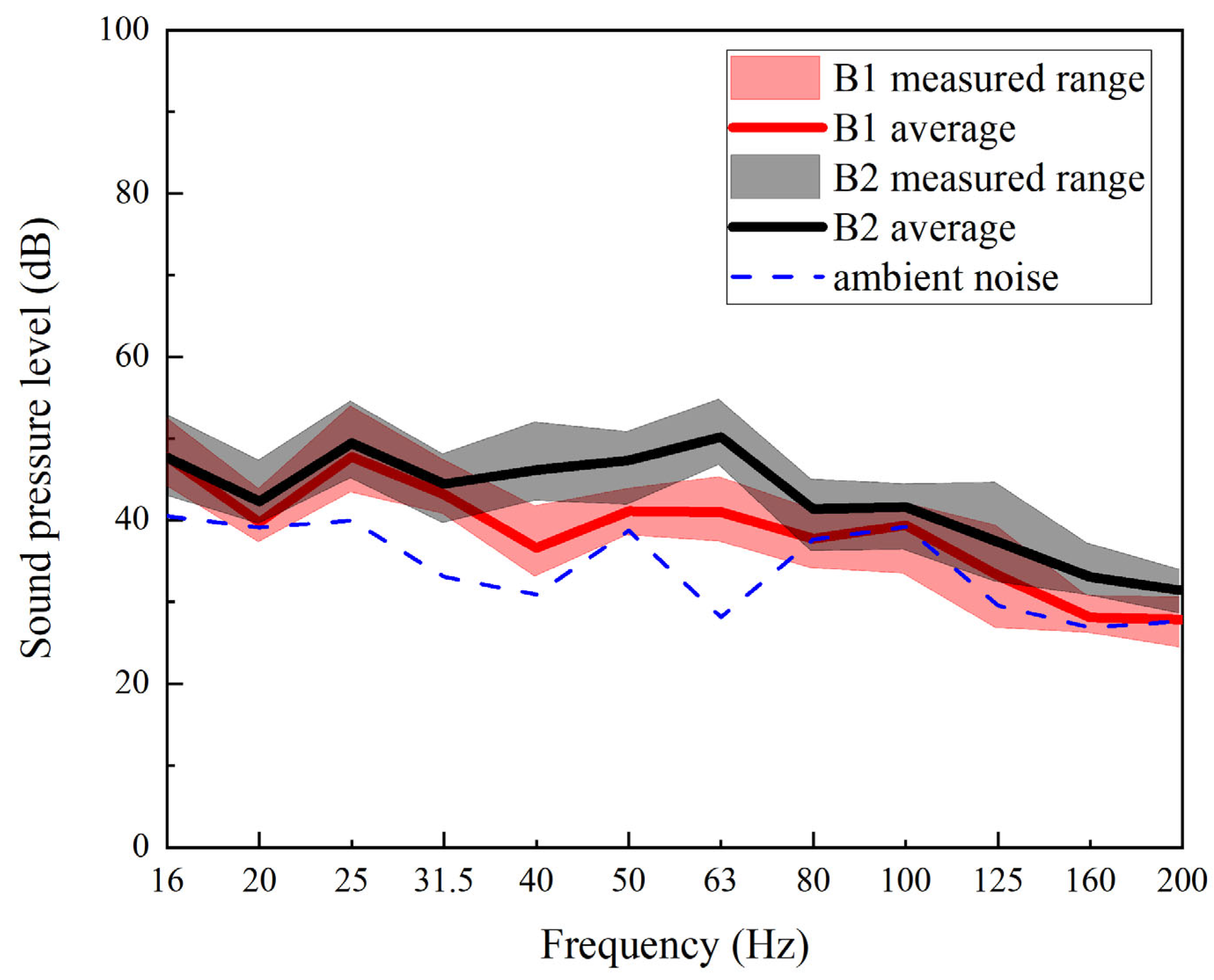
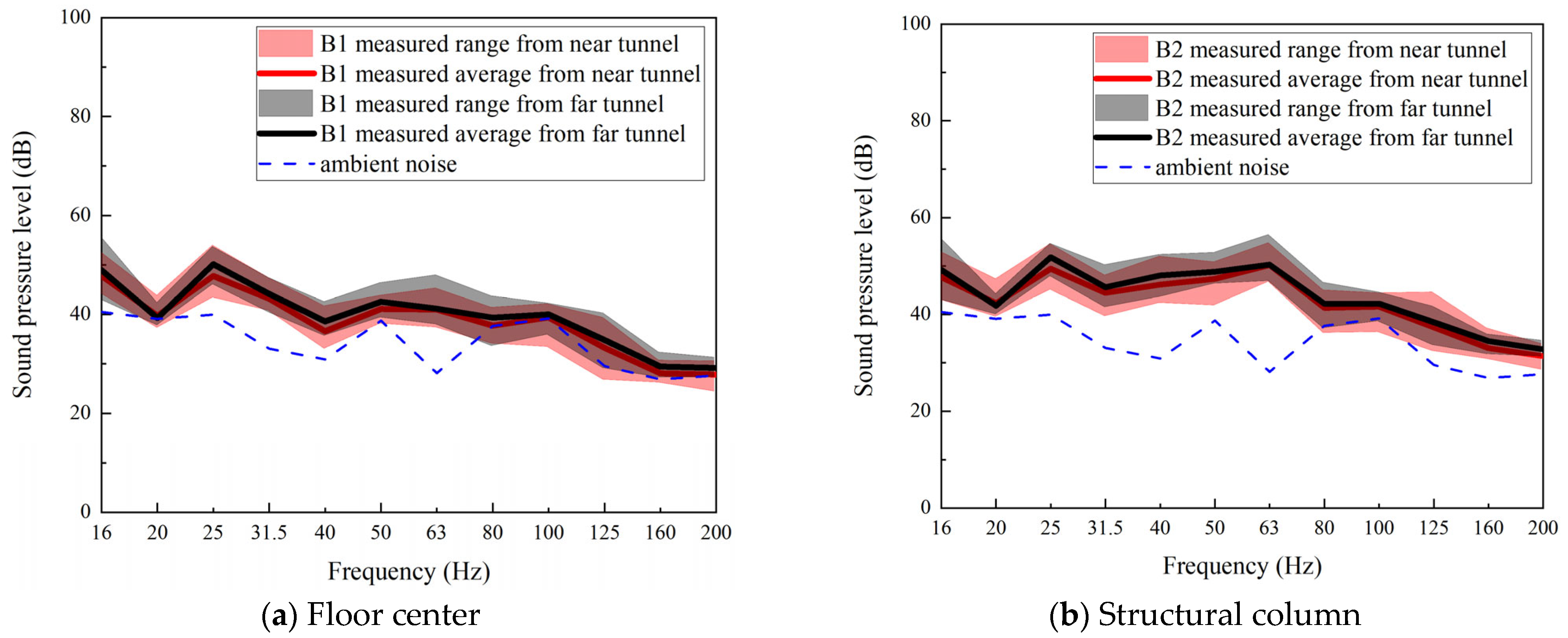
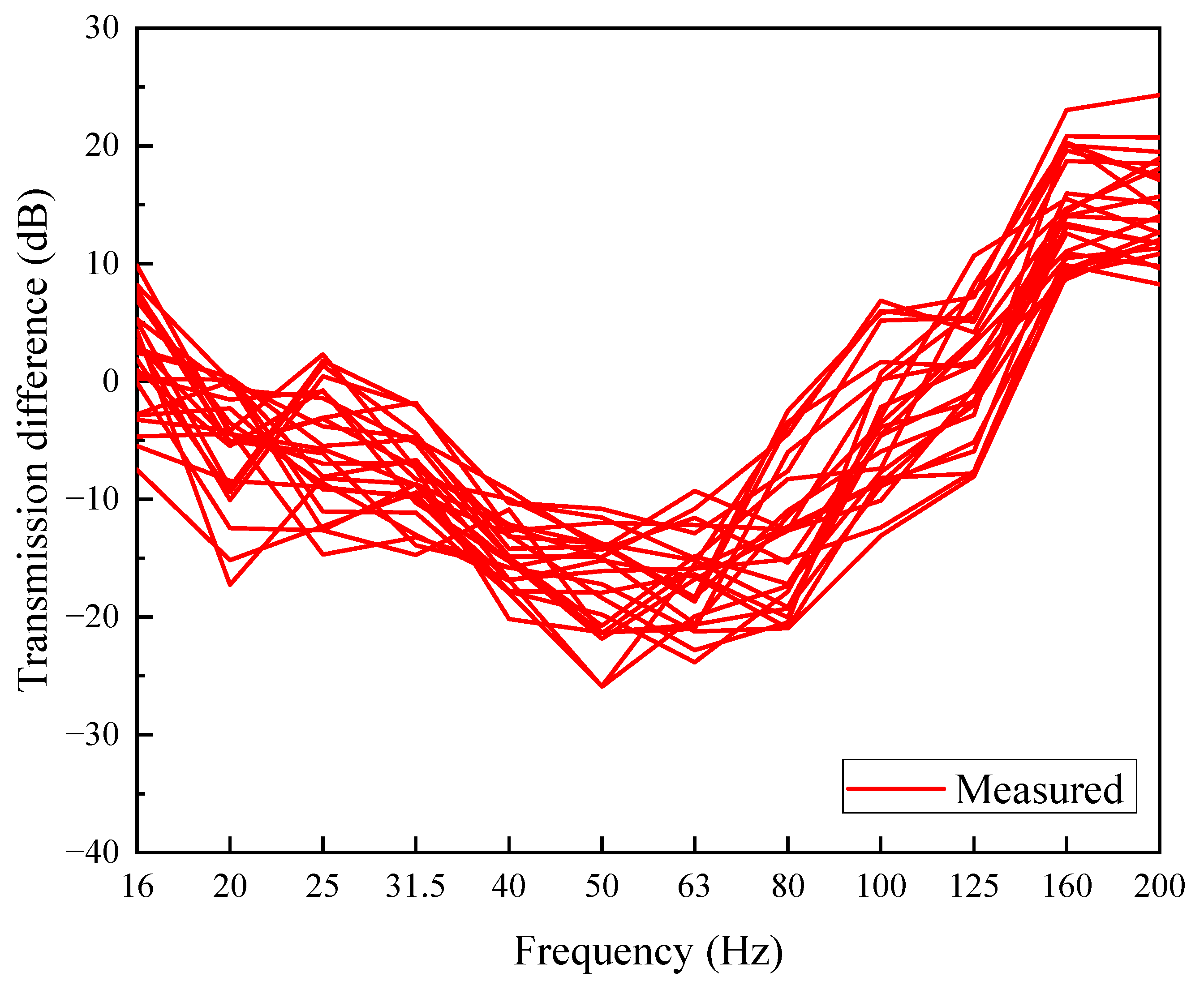
| Soil Name | Thickness (m) | Density (kg/m3) | Poisson’s Ratio | Young’s Modulus (MPa) |
|---|---|---|---|---|
| Plain fill | 2.1 | 1600 | 0.45 | 130 |
| Clay | 1.3 | 1840 | 0.46 | 130 |
| Silty soil | 8.4 | 1750 | 0.47 | 300 |
| Silty clay | 10.6 | 1930 | 0.46 | 380 |
| Floor Number | Load-Bearing Structure | h (m) | t (m) | w (m) | E (Gpa) | Ρ (kg/m3) |
|---|---|---|---|---|---|---|
| 1–2 | Structural column | 4 | 0.4 | 0.4 | 32.5 | 2500 |
| Floor Number | t (m) | E (Gpa) | l (m) | w (m) | ρ (kg/m3) |
|---|---|---|---|---|---|
| 1–3 | 0.1 | 30 | 6 | 6 | 2500 |
| Foundation Type | l (m) | w (m) | E (Gpa) | ρ (kg/m3) |
|---|---|---|---|---|
| Rigid foundation | 1.2 | 1.2 | 32.5 | 2500 |
Disclaimer/Publisher’s Note: The statements, opinions and data contained in all publications are solely those of the individual author(s) and contributor(s) and not of MDPI and/or the editor(s). MDPI and/or the editor(s) disclaim responsibility for any injury to people or property resulting from any ideas, methods, instructions or products referred to in the content. |
© 2024 by the authors. Licensee MDPI, Basel, Switzerland. This article is an open access article distributed under the terms and conditions of the Creative Commons Attribution (CC BY) license (https://creativecommons.org/licenses/by/4.0/).
Share and Cite
Chen, J.; Hou, S.; Zheng, B.; Li, X.; Peng, F.; Wang, Y.; Chen, J. Train-Induced Vibration and Structure-Borne Noise Measurement and Prediction of Low-Rise Building. Buildings 2024, 14, 2883. https://doi.org/10.3390/buildings14092883
Chen J, Hou S, Zheng B, Li X, Peng F, Wang Y, Chen J. Train-Induced Vibration and Structure-Borne Noise Measurement and Prediction of Low-Rise Building. Buildings. 2024; 14(9):2883. https://doi.org/10.3390/buildings14092883
Chicago/Turabian StyleChen, Jialiang, Sen Hou, Bokai Zheng, Xuming Li, Fangling Peng, Yingying Wang, and Junjie Chen. 2024. "Train-Induced Vibration and Structure-Borne Noise Measurement and Prediction of Low-Rise Building" Buildings 14, no. 9: 2883. https://doi.org/10.3390/buildings14092883







